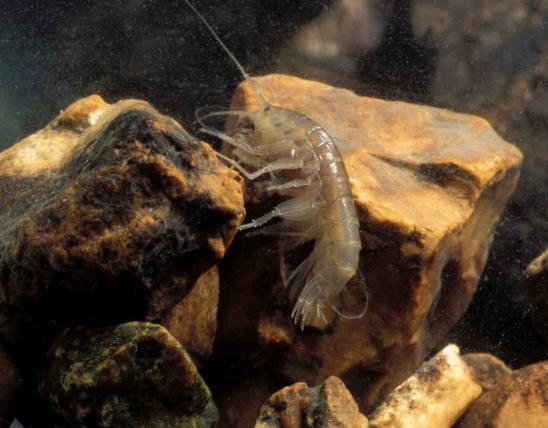
The Caney Mountain cave crayfish is blind and white, with long, narrow pincers and very long antennae. Identification of this species is primarily by location, as our other two cave crayfish are found in different cave systems in southern Missouri.
Length: about 2–2½ inches.

Known only from a single cave system in Ozark County, Missouri.
Habitat and Conservation
Like other cave crayfish, this species lives in cave streams and underground lakes and may sometimes be collected at the mouths of springs. The Caney Mountain cave crayfish was collected for the first time in 1999 and is known from only one location. It is the only cave species of this genus found west of the Mississippi River. This is a rare species with a very restricted range, and it is vulnerable to extirpation. Keeping groundwater clean is a key to its survival.
Food
Crayfish are generally omnivores, eating a wide variety of plant and animal materials. Because green plants are scarce inside caves, this species undoubtedly eats a larger proportion of animal material (as a predator of live animals, or a scavenger of dead ones) than other crayfish.
Status
A species of conservation concern in Missouri. Endemic to (only found in) our state. The presence of this rare species in a single cave system may be explained by crayfish distributional patterns hundreds of thousands of years ago, before the Mississippi River took its present form. Apparently, an ancestral non-cave crayfish species was wide-ranging, but as the river and other streams changed their flow patterns and carved valleys into what would become the Ozarks, populations of the crayfish became isolated from each other, with some being isolated in caves, with this species as one of the descendants. There might be other relict cave species that simply haven't been found yet.
Life Cycle
Detailed knowledge of this species' reproductive cycle is not known. Crayfish molt as they grow, discarding the old shell and replacing it with a new, larger one. After mating, the female carries the eggs, then the young, under her abdomen, attached to swimmerets, which are small appendages on the bottom of the abdomen.
Human Connections
Surface water from rain washes pollutants such as fertilizers, pesticides, and other substances into the groundwater, which eventually seeps into cave systems and into our drinking water as well. Many people believe that humans are obligated to care for the natural world, and curbing pollutants is part of that responsibility.
Ecosystem Connections
Crayfish eat a variety of materials, including living and dead animal life, and this cave crayfish undoubtedly feeds on cave isopods and other animals that live in the streams in caves. Crayfish, living or dead, are in turn an important food for many other animals.
































